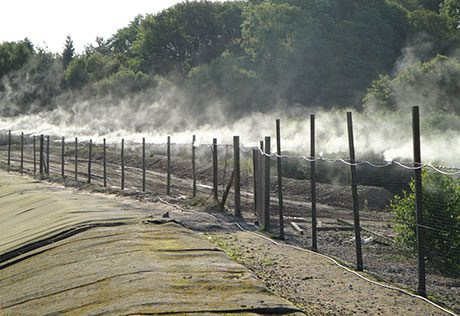Perhaps the most persistent problem plaguing the waste industry is nuisance odour. David Hill, president of GOC Technologies, believes new techniques could help restore public confidence

WE often hear that odour is subjective and variable and for both physical and psychological reasons, odour perception is certainly variable.
Each of us has a ‘receptor plate’ at the back of our olfactory systems which receives molecules from the air from ‘fragranced’ compounds, whether that fragrance is pleasant, unpleasant, or anything in between.
The compound molecule fits into an odour receptor, which then sends a synapse to the brain identifying and qualifying the odour. Any molecules which cannot find an open receptor do not contribute to the synapse. Interestingly enough, these receptors come in seven different shapes, and all the odorous compounds – good and bad – seem to fit in one of these seven shapes.
However, nature didn’t see fit to give each of us the same quantity of each receptor. Some people have very evenly distributed receptors and typically make good testers for perfumes, coffees, and wines (and are paid handsomely for their ‘talents’). On the other hand, some people may have 30% or one kind and nearly none of another, or any other odd combination. This opens the door to highly variable perception. Add to this the ability of odorous vapours to move with every air current and shear, and it is no wonder that an odour complaint may come from one or two homes while residents 50 metres away are not impacted.
Many solid waste activities occur in open air situations such as windrow composting and landfilling. Any movement of organic wastes presents the possibility for volatilisation of odorous compounds, and since both operations, but especially composting, are ripe with various processing (moving) of the wastes, it is small wonder that many odorous situations are reported. With many of these odorous compounds, the processes that initiate volatilisation continue unabated even after motion starts. In plain talk, if you once start the formation and release of the odour, it is very difficult to stop it until the compounds involved are exhausted.
In an open air environment the potential footprint for odour generation is large and ill-defined. Conventional odour control technologies such as scrubbers and biofilters are of little use when the offensive air may come from a myriad of places and activities, and become almost instantly airborne.
Simply due to lack of alternatives, one method of treatment attempted is often the atomising or misting of deodorisers, neutralisers, or masking agents mixed with water around the site or around the potentially odorous area(s) of the site. While very common, in my view and the view of most regulatory professionals, this method is largely unsuccessful and poorly regarded. Again there are fundamental physical and chemical reasons for this lack of success.
The odours being perceived have been converted to the vapour phase (usually by heat or pressure). In this volatile, gaseous phase, their molecular weights are very low, and their particle sizes are typically less than 1 micron. It then becomes physically impossible for a water based particle coming out of a nozzle at 15 to 75 microns in size and considerably greater weight, to move at the same speed as the odours, to go to the same places as the odours, or to stay in the air as long as the odours.
Many odorous compounds are detectable at less than 1 part odourant to 1 billion parts air. To be successful, any atomisation or misting technology would need to be able to find and contact that one part of odourant. Any water based particle of even 5 microns in diameter will simply be too heavy to keep up with a gas. The only thing that has a chance of contacting and impacting these odorous vapours once they are airborne is another vapour. This could be accomplished by using some form of gasification or vaporisation delivery system, and a deodoriser specifically formulated to work in the vapour phase.
Another possibility would be a deodoriser with a significantly faster evaporation rate and a lower evaporation threshold than water. Water could be used to deliver the deodoriser to the nozzles, but upon contact with air, the deodoriser would leave the water and continue on in the vapour phase. Such chemistry is achievable, as is vaporisation technology. Indeed, initial offerings of both technologies are beginning to appear in the market place.
These new technologies may provide much needed help and hope for troubled facilities and operations. Perhaps with a success story or two, they may even gain the confidence of the regulatory agencies and the public.







